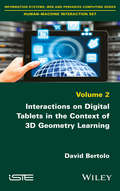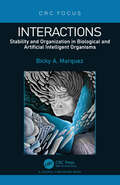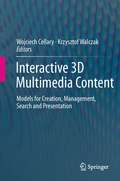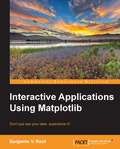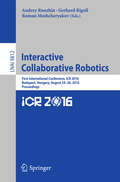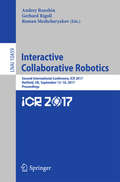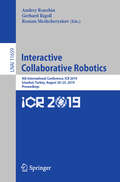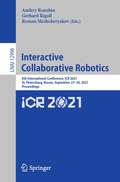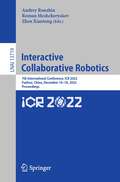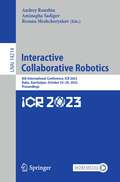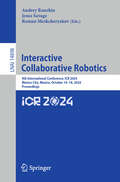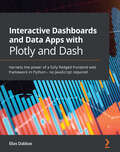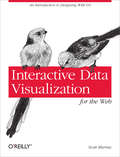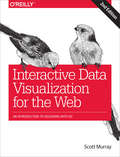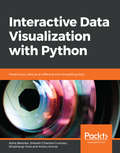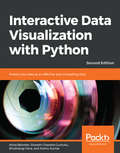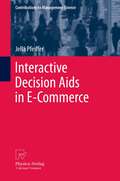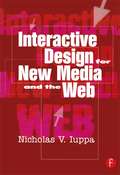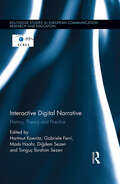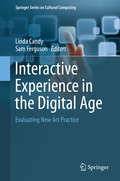- Table View
- List View
Interactions on Digital Tablets in the Context of 3D Geometry Learning: Contributions and Assessments
by David BertoloOver the last few years, multi-touch mobile devices have become increasingly common. However, very few applications in the context of 3D geometry learning can be found in app stores. Manipulating a 3D scene with a 2D device is the main difficulty of such applications. Throughout this book, the author focuses on allowing young students to manipulate, observe and modify 3D scenes using new technologies brought about by digital tablets. Through a user-centered approach, the author proposes a grammar of interactions adapted to young learners, and then evaluates acceptability, ease of use and ease of learning of the interactions proposed. Finally, the author studies in situ the pedagogic benefits of the use of tablets with an app based on the suggested grammar. The results show that students are able to manipulate, observe and modify 3D scenes using an adapted set of interactions. Moreover, in the context of 3D geometry learning, a significant contribution has been observed in two classes when students use such an application. The approach here focuses on interactions with digital tablets to increase learning rather than on technology. First, defining which interactions allow pupils to realize tasks needed in the learning process, then, evaluating the impact of these interactions on the learning process. This is the first time that both interactions and the learning process have been taken into account at the same time.
Interactions with Search Systems
by Ryen W. WhiteInformation seeking is a fundamental human activity. In the modern world, it is frequently conducted through interactions with search systems. The retrieval and comprehension of information returned by these systems is a key part of decision making and action in a broad range of settings. Advances in data availability coupled with new interaction paradigms, and mobile and cloud computing capabilities, have created a broad range of new opportunities for information access and use. In this comprehensive book for professionals, researchers, and students involved in search system design and evaluation, search expert Ryen White discusses how search systems can capitalize on new capabilities and how next-generation systems must support higher order search activities such as task completion, learning, and decision making. He outlines the implications of these changes for the evolution of search evaluation, as well as challenges that extend beyond search systems in areas such as privacy and societal benefit.
Interactions: Stability and Organization in Biological and Artificial Intelligent Organisms
by Bicky A. MarquezThis book examines how predicting the future based on analytical and empirical models is essential for our species' survival, stable organization, and well-being. At a high level, information exchange, mainly through communication between people, fosters a deeper understanding of reality and strengthens human bonds, ultimately contributing to the emergence of societies as new creatures or "superorganisms" with significantly more data to feed those models. Communication is fundamental to the development of complex organisms, the maintenance of internal order, and the propagation of knowledge via cultural packets. The human brain's plasticity, memory, and learning capabilities enable storage and rapid responses to new information, enhancing our decision-making and forecasting abilities. The book discusses the complexity of multicellular organisms and the mechanisms that coordinate their internal subsystems, highlighting the emergence of hierarchies from fundamental particles to networks of superorganisms. The interconnectedness of biological oscillators with prominent similarities enables synchronization as a foundation for their superior organization and collective agreements. Finally, this book explores the human quest to enhance survival through accumulating knowledge and developing tools and technologies. It underscores the significance of artificial intelligence as a tool to support cognitive abilities and address global challenges while acknowledging our limited control over reality within an independently operating universe.
Interactive 3D Multimedia Content
by Krzysztof Walczak Wojciech CellaryThe book describes recent research results in the areas of modelling, creation, management and presentation of interactive 3D multimedia content. The book describes the current state of the art in the field and identifies the most important research and design issues. Consecutive chapters address these issues. These are: database modelling of 3D content, security in 3D environments, describing interactivity of content, searching content, visualization of search results, modelling mixed reality content, and efficient creation of interactive 3D content. Each chapter is illustrated with example applications based on the proposed approach. The final chapter discusses some important ethical issues related to the widespread use of virtual environments in everyday life. The book provides ready to use solutions for many important problems related to the creation of interactive 3D multimedia applications and will be a primary reading for researchers and developers working in this domain.
Interactive Applications Using Matplotlib
by Benjamin V. RootThis book is intended for Python programmers who want to do more than just see their data. Experience with GUI toolkits is not required, so this book can be an excellent complement to other GUI programming resources.
Interactive Collaborative Robotics
by Andrey Ronzhin Gerhard Rigoll Roman MeshcheryakovThis book constitutes the proceedings of the First International Conference on Interactive Collaborative Robotics, ICR 2016, held in Budapest, Hungary, in August 2016. The 29 papers presented in this volume were carefully reviewed and selected from 48 submissions.
Interactive Collaborative Robotics
by Andrey Ronzhin Gerhard Rigoll Roman MeshcheryakovThis book constitutes the proceedings of the Second International Conference on Interactive Collaborative Robotics, ICR 2017, held in Hatfield, UK, in September 2017, as a satellite event of the 19th International Conference on Speech and Computer, SPECOM 2017. The 30 papers presented in this volume were carefully reviewed and selected from 51 submissions. This new conference invites researchers in the area of social robotics and collaborative robotics to share experience in human-machine interaction research and development of robotic and cyberphysical systems. Topics addressed are: assistive robots, child-robot interaction, collaborative robotics, educational robotics, human-robot interaction, medical robotics, robotic mobility systems, robots at home, robot control and communication, social robotics, as well as safety robot behavior.
Interactive Collaborative Robotics: 4th International Conference, ICR 2019, Istanbul, Turkey, August 20–25, 2019, Proceedings (Lecture Notes in Computer Science #11659)
by Andrey Ronzhin Gerhard Rigoll Roman MeshcheryakovThis book constitutes the refereed proceedings of the 4th International Conference on Interactive Collaborative Robotics, ICR 2019, held in Istanbul, Turkey, in August 2019. The 32 papers presented in this volume were carefully reviewed and selected from 46 submissions. They deal with challenges of human-robot interaction; robot control and behavior in social robotics and collaborative robotics; and applied robotic and cyber-physical systems.
Interactive Collaborative Robotics: 5th International Conference, ICR 2020, St Petersburg, Russia, October 7-9, 2020, Proceedings (Lecture Notes in Computer Science #12336)
by Andrey Ronzhin Gerhard Rigoll Roman MeshcheryakovThis book constitutes the proceedings of the 5th International Conference on Interactive Collaborative Robotics, ICR 2020, held in St. Petersburg, Russia, in October 2020. The 31 papers presented were carefully reviewed and selected from 62 submissions. Challenges of human-robot interaction, robot control and behavior in social robotics and collaborative robotics, as well as applied robotic and cyber-physical systems are mainly discussed in the papers.
Interactive Collaborative Robotics: 6th International Conference, ICR 2021, St. Petersburg, Russia, September 27–30, 2021, Proceedings (Lecture Notes in Computer Science #12998)
by Andrey Ronzhin Gerhard Rigoll Roman MeshcheryakovThis book constitutes the proceedings of the 6th International Conference on Interactive Collaborative Robotics, ICR 2021, held in St. Petersburg, Russia, in October 2021. The 19 papers presented were carefully reviewed and selected from 40 submissions. Challenges of human-robot interaction, robot control and behavior in social robotics and collaborative robotics, as well as applied robotic and cyber-physical systems are mainly discussed in the papers.
Interactive Collaborative Robotics: 7th International Conference, ICR 2022, Fuzhou, China, December 16-18, 2022, Proceedings (Lecture Notes in Computer Science #13719)
by Andrey Ronzhin Roman Meshcheryakov Zhen XiantongThis book constitutes the proceedings of the 7th International Conference on Interactive Collaborative Robotics, ICR 2022, held in Fuzhou, China, in December 2022. The 25 papers presented were carefully reviewed and selected from 45 submissions. Challenges of human-robot interaction, robot control and behavior in social robotics and collaborative robotics, as well as applied robotic and cyber-physical systems are mainly discussed in the papers.
Interactive Collaborative Robotics: 8th International Conference, ICR 2023, Baku, Azerbaijan, October 25–29, 2023, Proceedings (Lecture Notes in Computer Science #14214)
by Andrey Ronzhin Roman Meshcheryakov Aminagha SadigovThis book constitutes the refereed proceedings of the 8th International Conference on Interactive Collaborative Robotics, ICR 2023, held in Baku, Azerbaijan, during October 25–29, 2023.The 33 full papers included in this book were carefully reviewed and selected from 56 submissions. They were organized in topical sections as follows: focused the foundations and means of collaborative behavior of one or more robots physically interacting with hu-mans in operational environments configured with embedded sensor networks and cloud services under uncertainty and environmental variability.
Interactive Collaborative Robotics: 9th International Conference, ICR 2024, Mexico City, Mexico, October 14–18, 2024, Proceedings (Lecture Notes in Computer Science #14898)
by Andrey Ronzhin Roman Meshcheryakov Jesus SavageThis book constitutes the refereed proceedings of the 9th International Conference on Interactive Collaborative Robotics, ICR 2024, held in Mexico City, Mexico, during October 14–18, 2024. The 32 full papers presented here were carefully reviewed and selected from 62 submissions. These papers focus on the challenges, trends and applications of Human-Robot collaboration in various domains such as Industry, Healthcare, Society and Education.
Interactive Collaborative Robotics: Third International Conference, ICR 2018, Leipzig, Germany, September 18–22, 2018, Proceedings (Lecture Notes in Computer Science #11097)
by Andrey Ronzhin Gerhard Rigoll Roman MeshcheryakovThis book constitutes the proceedings of the Third International Conference on Interactive Collaborative Robotics, ICR 2018, held in Leipzig, Germany, in September 2018, as a satellite event of the 20th International Conference on Speech and Computer, SPECOM 2018.The 30 papers presented in this volume were carefully reviewed and selected from 51 submissions. The papers presents challenges of human-robot interaction, robot control and behavior in social robotics and collaborative robotics, as well as applied robotic and cyberphysical systems.
Interactive Dashboards and Data Apps with Plotly and Dash: Harness the power of a fully fledged frontend web framework in Python – no JavaScript required
by Elias DabbasBuild web-based, mobile-friendly analytic apps and interactive dashboards with PythonKey FeaturesDevelop data apps and dashboards without any knowledge of JavaScriptMap different types of data such as integers, floats, and dates to bar charts, scatter plots, and moreCreate controls and visual elements with multiple inputs and outputs and add functionality to the app as per your requirementsBook DescriptionPlotly's Dash framework is a life-saver for Python developers who want to develop complete data apps and interactive dashboards without JavaScript, but you'll need to have the right guide to make sure you're getting the most of it. With the help of this book, you'll be able to explore the functionalities of Dash for visualizing data in different ways.Interactive Dashboards and Data Apps with Plotly and Dash will first give you an overview of the Dash ecosystem, its main packages, and the third-party packages crucial for structuring and building different parts of your apps. You'll learn how to create a basic Dash app and add different features to it.Next, you'll integrate controls such as dropdowns, checkboxes, sliders, date pickers, and more in the app and then link them to charts and other outputs. Depending on the data you are visualizing, you'll also add several types of charts, including scatter plots, line plots, bar charts, histograms, and maps, as well as explore the options available for customizing them.By the end of this book, you'll have developed the skills you need to create and deploy an interactive dashboard, handle complexities and code refactoring, and understand the process of improving your application.What you will learnFind out how to run a fully interactive and easy-to-use appConvert your charts to various formats including images and HTML filesUse Plotly Express and the grammar of graphics for easily mapping data to various visual attributesCreate different chart types, such as bar charts, scatter plots, histograms, maps, and moreExpand your app by creating dynamic pages that generate content based on URLsImplement new callbacks to manage charts based on URLs and vice versaWho this book is forThis Plotly Dash book is for data professionals and data analysts who want to gain a better understanding of their data with the help of different visualizations and dashboards – and without having to use JS. Basic knowledge of the Python programming language and HTML will help you to grasp the concepts covered in this book more effectively, but it's not a prerequisite.
Interactive Data Processing and 3D Visualization of the Solid Earth
by Daniel PatelThis book presents works detailing the application of processing and visualization techniques for analyzing the Earth’s subsurface. The topic of the book is interactive data processing and interactive 3D visualization techniques used on subsurface data. Interactive processing of data together with interactive visualization is a powerful combination which has in the recent years become possible due to hardware and algorithm advances in. The combination enables the user to perform interactive exploration and filtering of datasets while simultaneously visualizing the results so that insights can be made immediately. This makes it possible to quickly form hypotheses and draw conclusions. Case studies from the geosciences are not as often presented in the scientific visualization and computer graphics community as e.g., studies on medical, biological or chemical data. This book will give researchers in the field of visualization and computer graphics valuable insight into the open visualization challenges in the geosciences, and how certain problems are currently solved using domain specific processing and visualization techniques. Conversely, readers from the geosciences will gain valuable insight into relevant visualization and interactive processing techniques. Subsurface data has interesting characteristics such as its solid nature, large range of scales and high degree of uncertainty, which makes it challenging to visualize with standard methods. It is also noteworthy that parallel fields of research have taken place in geosciences and in computer graphics, with different terminology when it comes to representing geometry, describing terrains, interpolating data and (example-based) synthesis of data. The domains covered in this book are geology, digital terrains, seismic data, reservoir visualization and CO2 storage. The technologies covered are 3D visualization, visualization of large datasets, 3D modelling, machine learning, virtual reality, seismic interpretation and multidisciplinary collaboration. People within any of these domains and technologies are potential readers of the book.
Interactive Data Visualization for the Web
by Scott MurrayCreate and publish your own interactive data visualization projects on the Web--even if you have little or no experience with data visualization or web development. It's easy and fun with this practical, hands-on introduction. Author Scott Murray teaches you the fundamental concepts and methods of D3, a JavaScript library that lets you express data visually in a web browser. Along the way, you'll expand your web programming skills, using tools such as HTML and JavaScript. This step-by-step guide is ideal whether you're a designer or visual artist with no programming experience, a reporter exploring the new frontier of data journalism, or anyone who wants to visualize and share data. Learn HTML, CSS, JavaScript, and SVG basics Dynamically generate web page elements from your data--and choose visual encoding rules to style them Create bar charts, scatter plots, pie charts, stacked bar charts, and force-directed layouts Use smooth, animated transitions to show changes in your data Introduce interactivity to help users explore data through different views Create customized geographic maps with data Explore hands-on with downloadable code and over 100 examples
Interactive Data Visualization for the Web: An Introduction to Designing with D3
by Scott MurrayCreate and publish your own interactive data visualization projects on the webâ??even if you have little or no experience with data visualization or web development. Itâ??s inspiring and fun with this friendly, accessible, and practical hands-on introduction. This fully updated and expanded second edition takes you through the fundamental concepts and methods of D3, the most powerful JavaScript library for expressing data visually in a web browser.Ideal for designers with no coding experience, reporters exploring data journalism, and anyone who wants to visualize and share data, this step-by-step guide will also help you expand your web programming skills by teaching you the basics of HTML, CSS, JavaScript, and SVG.Learn D3 4.xâ??the latest D3 versionâ??with downloadable code and over 140 examplesCreate bar charts, scatter plots, pie charts, stacked bar charts, and force-directed graphsUse smooth, animated transitions to show changes in your dataIntroduce interactivity to help users explore your dataCreate custom geographic maps with panning, zooming, labels, and tooltipsWalk through the creation of a complete visualization project, from start to finishExplore inspiring case studies with nine accomplished designers talking about their D3-based projects
Interactive Data Visualization with Python: Present your data as an effective and compelling story
by Shubhangi Hora Abha Belorkar Sharath Chandra Guntuku Anshu KumarCreate your own clear and impactful interactive data visualizations with the powerful data visualization libraries of Python Key Features Study and use Python interactive libraries, such as Bokeh and Plotly Explore different visualization principles and understand when to use which one Create interactive data visualizations with real-world data Book Description With so much data being continuously generated, developers, who can present data as impactful and interesting visualizations, are always in demand. Interactive Data Visualization with Python sharpens your data exploration skills, tells you everything there is to know about interactive data visualization in Python. You'll begin by learning how to draw various plots with Matplotlib and Seaborn, the non-interactive data visualization libraries. You'll study different types of visualizations, compare them, and find out how to select a particular type of visualization to suit your requirements. After you get a hang of the various non-interactive visualization libraries, you'll learn the principles of intuitive and persuasive data visualization, and use Bokeh and Plotly to transform your visuals into strong stories. You'll also gain insight into how interactive data and model visualization can optimize the performance of a regression model. By the end of the course, you'll have a new skill set that'll make you the go-to person for transforming data visualizations into engaging and interesting stories. What you will learn Explore and apply different static and interactive data visualization techniques Make effective use of plot types and features from the Matplotlib, Seaborn, Altair, Bokeh, and Plotly libraries Master the art of selecting appropriate plotting parameters and styles to create attractive plots Choose meaningful and informative ways to present your stories through data Customize data visualization for specific scenarios, contexts, and audiences Avoid common errors and slip-ups in visualizing data Who this book is for This book intends to provide a solid training ground for Python developers, data analysts and data scientists to enable them to present critical data insights in a way that best captures the user's attention and imagination. It serves as a simple step-by-step guide that demonstrates the different types and components of visualization, the principles, and techniques of effective interactivity, as well as common pitfalls to avoid when creating interactive data visualizations. Students should have an intermediate level of competency in writing Python code, as well as some familiarity with using libraries such as pandas.
Interactive Data Visualization with Python: Present your data as an effective and compelling story, 2nd Edition
by Shubhangi Hora Abha Belorkar Anshu Kumar Sharath Chandra GuntukuCreate your own clear and impactful interactive data visualizations with the powerful data visualization libraries of Python Key Features Study and use Python interactive libraries, such as Bokeh and Plotly Explore different visualization principles and understand when to use which one Create interactive data visualizations with real-world data Book Description With so much data being continuously generated, developers, who can present data as impactful and interesting visualizations, are always in demand. Interactive Data Visualization with Python sharpens your data exploration skills, tells you everything there is to know about interactive data visualization in Python. You'll begin by learning how to draw various plots with Matplotlib and Seaborn, the non-interactive data visualization libraries. You'll study different types of visualizations, compare them, and find out how to select a particular type of visualization to suit your requirements. After you get a hang of the various non-interactive visualization libraries, you'll learn the principles of intuitive and persuasive data visualization, and use Bokeh and Plotly to transform your visuals into strong stories. You'll also gain insight into how interactive data and model visualization can optimize the performance of a regression model. By the end of the course, you'll have a new skill set that'll make you the go-to person for transforming data visualizations into engaging and interesting stories. What you will learn Explore and apply different interactive data visualization techniques Manipulate plotting parameters and styles to create appealing plots Customize data visualization for different audiences Design data visualizations using interactive libraries Use Matplotlib, Seaborn, Altair and Bokeh for drawing appealing plots Customize data visualization for different scenarios Who this book is for This book intends to provide a solid training ground for Python developers, data analysts and data scientists to enable them to present critical data insights in a way that best captures the user's attention and imagination. It serves as a simple step-by-step guide that demonstrates the different types and components of visualization, the principles, and techniques of effective interactivity, as well as common pitfalls to avoid when creating interactive data visualizations. Students should have an intermediate level of competency in writing Python code, as well as some familiarity with using libraries such as pandas.
Interactive Data Visualization: Foundations, Techniques, and Applications, Second Edition
by Daniel Keim Matthew O. Ward Georges GrinsteinAn Updated Guide to the Visualization of Data for Designers, Users, and ResearchersInteractive Data Visualization: Foundations, Techniques, and Applications, Second Edition provides all the theory, details, and tools necessary to build visualizations and systems involving the visualization of data. In color throughout, it explains basic terminology
Interactive Decision Aids in E-Commerce
by Jella PfeifferThis book gives recommendations on which interactive decision aids to offer in webstores. Interactive decision aids are tools that help online shoppers to compare and evaluate product information. Consumers can, for instance, exclude products that do not meet certain criteria, they can highlight certain information or they can assign ratings of different kinds. Interactive decision aids are important, because finding the preferred product in a short amount of time increases both the customers' satisfaction and, in turn, the sales volume.This book includes a detailed description of decision aids, closely studies how decision aids are related to the decision behavior of customers, and develops a comprehensive system of decision aids, which is very flexible, increases both customer satisfaction and confidence, and can be used intuitively. The close link between typical behaviors and the decision aids allows webstores to learn about customers' decision-making behavior by using a simple click stream analysis. The book is written in an easy-to-read style and provides both practical recommendations and knowledge about consumer behavior
Interactive Design for New Media and the Web
by Nick IuppaIn an age where digital technology makes just about anything possible, Interactive Design for New Media and the Web demonstrates how to realize that promise through the creation of outstanding interactive programs. This hands-on, practical book examines the ever-expanding capabilities of all forms of digital presentation for increasing interactivity, and the design principles and interface guidelines needed to deliver the required message or story with this technology. Interactive Design for New Media and the Web covers the technology as well as the tools and practices of interactive design, including the creation of site maps and flow charts, and the writing of design documents. It examines the latest interactive features of DVD, as well as the newest techniques and technologies for other forms of digital presentation. New design templates, 3D graphics and animation, polling and use of cookies, distance learning, html, and intranet learning games are among the topics covered in this book. Examples and case studies demonstrate the broad range of applications from websites to CD-ROM games to successful web commerce sites, including the capacity for user participation in e-commerce.The companion Website shows numerous examples discussed in the text of all types of programs and their applications.
Interactive Digital Narrative: History, Theory and Practice (Routledge Studies in European Communication Research and Education)
by Hartmut Koenitz Mads Haahr Gabriele Ferri Diğdem Sezen Tonguç İbrahim SezenThe book is concerned with narrative in digital media that changes according to user input—Interactive Digital Narrative (IDN). It provides a broad overview of current issues and future directions in this multi-disciplinary field that includes humanities-based and computational perspectives. It assembles the voices of leading researchers and practitioners like Janet Murray, Marie-Laure Ryan, Scott Rettberg and Martin Rieser. In three sections, it covers history, theoretical perspectives and varieties of practice including narrative game design, with a special focus on changes in the power relationship between audience and author enabled by interactivity. After discussing the historical development of diverse forms, the book presents theoretical standpoints including a semiotic perspective, a proposal for a specific theoretical framework and an inquiry into the role of artificial intelligence. Finally, it analyses varieties of current practice from digital poetry to location-based applications, artistic experiments and expanded remakes of older narrative game titles.
Interactive Experience in the Digital Age
by Linda Candy Sam FergusonThe use of interactive technology in the arts has changed the audience from viewer to participant and in doing so is transforming the nature of experience. From visual and sound art to performance and gaming, the boundaries of what is possible for creation, curating, production and distribution are continually extending. As a consequence, we need to reconsider the way in which these practices are evaluated. Interactive Experience in the Digital Age explores diverse ways of creating and evaluating interactive digital art through the eyes of the practitioners who are embedding evaluation in their creative process as a way of revealing and enhancing their practice. It draws on research methods from other disciplines such as interaction design, human-computer interaction and practice-based research more generally and adapts them to develop new strategies and techniques for how we reflect upon and assess value in the creation and experience of interactive art. With contributions from artists, scientists, curators, entrepreneurs and designers engaged in the creative arts, this book is an invaluable resource for both researchers and practitioners, working in this emerging field.
